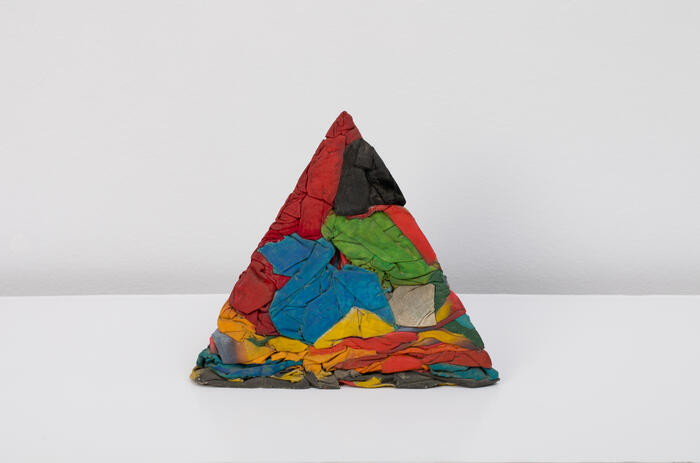CLAUDIA JOSKOWIZC, SOLO EXHBITION AT VALENCIA
Valencian gallery Jorge Lopez is programming a solo exhibition by artist Claudia Joskowizc (Santa Cruz de la Sierra, Bolivia, 1968) that brings together the audiovisual and performative techniques with which the Bolivian artist builds the narrative and chronology of her native country.
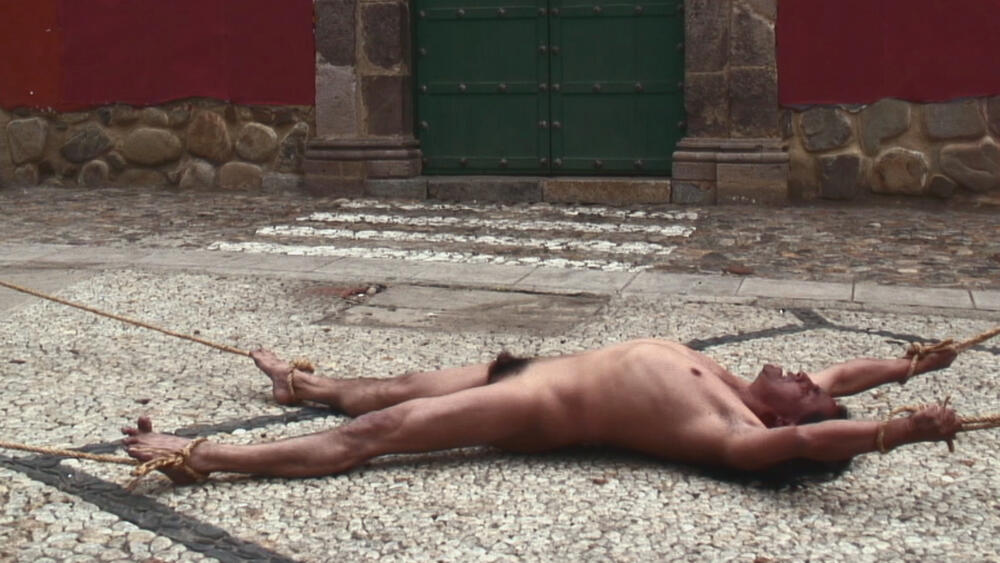
In the specific case of Intersecciones, as the exhibition is named and on view through June 1, Joskowizc reconstructs part of that social and artistic imagery gathered in the collective subconscious, with recreations and impact actions that aim at perpetuating the memory of several acts that have been building that history.
Thus, in Recreaciones (2007-2009) the Bolivian artist proposes to reinterpret three specific episodes staged in Bolivia through video art: the exhibition of Che Guevara's corpse, the medieval execution of the native icon of resistance Tupac Katari, and the plot surrounding the murders of Butch Cassidy and the Sundance Kid. The exhibition is completed with Cada edificio de la Avenida Alfonso Ugarte - Según Ruscha, from 2011, a video installation inspired by the North American pop master and with allusions to cinema that reflects the daily life of Warhol's projections, which alludes to a reality framed in places of a social-historical nature.
Intersecciones will be open to the public at Jorge Lopez Gallery, Valencia, Spain. From April 18 to June 1.
Related Topics
May interest you
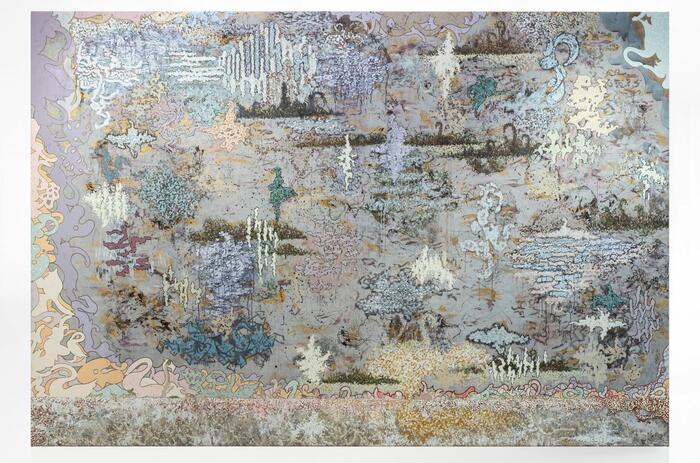
Flavio Garciandía (Caibarién, Cuba, 1954) becomes the active and passive subject of his work in his first solo exhibition in Madrid.
FLAVIO GARCIANDÍA’S SELF-REVISIONISM
Flavio Garciandía (Caibarién, Cuba, 1954) becomes the active and passive subject of his work in his first solo exhibition in Madrid.

Flavio Garciandía (Caibarién, Cuba, 1954) becomes the active and passive subject of his work in his first solo exhibition in Madrid.
FLAVIO GARCIANDÍA’S SELF-REVISIONISM
Flavio Garciandía (Caibarién, Cuba, 1954) becomes the active and passive subject of his work in his first solo exhibition in Madrid.
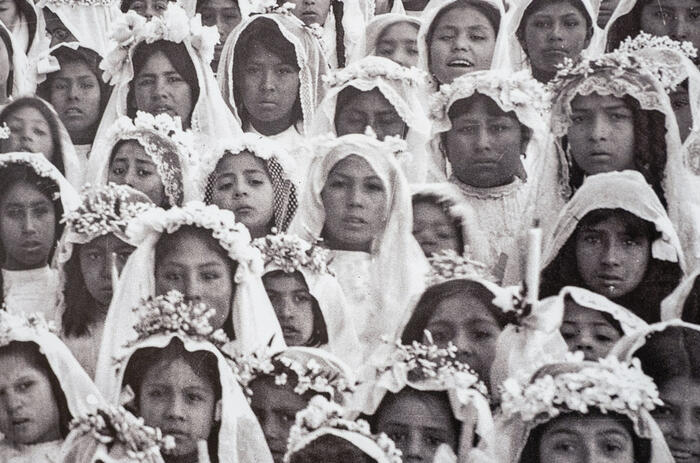
Casa de América inaugurated two exhibitions of Peruvian art: Memoria del Perú. Photographs 1890-1950, with works by various photographers that capture a significant period in the country's history, and Shipibo-Konibo. Portraits of my blood, with photographs by artist David Diaz on the life of the Shipibo-Konibo.
TWO EXHIBITIONS OF PERUVIAN PHOTOGRAPHY AT CASA DE AMERICA
Casa de América inaugurated two exhibitions of Peruvian art: Memoria del Perú. Photographs 1890-1950, with works by various photographers that capture a significant period in the country's history, and Shipibo-Konibo. Portraits of my blood, with photographs by artist David Diaz on the life of the Shipibo-Konibo.
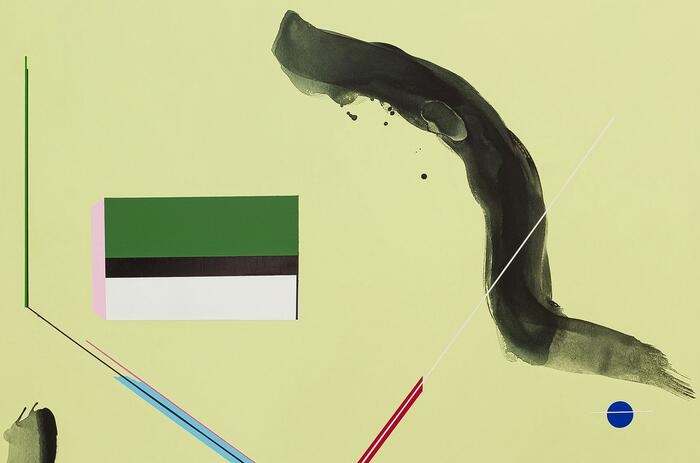
The geometry in Jorge Cabieses' (Lima, Peru, 1971) usual outline is broken with the action of the spontaneity of the curved and almost organic stroke in his second solo exhibition in the Spanish capital. The Lima-born artist thus proposes, in a certain way, a dialogue between the artificial of the synthetic and the atavistic through the incorporation of those more spontaneous brushstrokes over the usual framework of rectitude that the artist usually presents.
CABIESES’ INTERCEPTED IMAGE
The geometry in Jorge Cabieses' (Lima, Peru, 1971) usual outline is broken with the action of the spontaneity of the curved and almost organic stroke in his second solo exhibition in the Spanish capital. The Lima-born artist thus proposes, in a certain way, a dialogue between the artificial of the synthetic and the atavistic through the incorporation of those more spontaneous brushstrokes over the usual framework of rectitude that the artist usually presents.
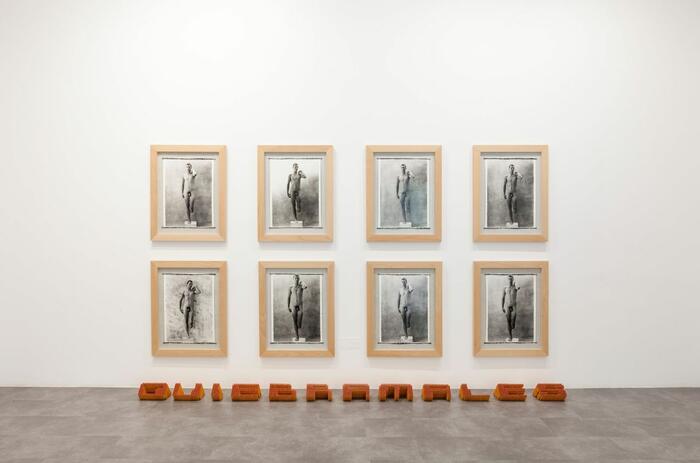
Two decades after Miguel Ángel Rojas (1946, Bogotá, Colombia) conceptualized in his project David Quiebramales his denunciation of violence and the use of education as the most efficient vehicle towards a catharsis for those who suffer it, the Madrid headquarters of La Cometa revisits his most emblematic work and reinterprets it as the framework for a kind of thematic retrospective. This commemoration of that first David Quiebramales reinforces a view that is still difficult to overcome and that, even today, serves to trace those harmful social dynamics that are created between society and war, the institutional and the political systems.
TOWARDS MIGUEL ÁNGEL ROJAS' QUIEBRAMALES
Two decades after Miguel Ángel Rojas (1946, Bogotá, Colombia) conceptualized in his project David Quiebramales his denunciation of violence and the use of education as the most efficient vehicle towards a catharsis for those who suffer it, the Madrid headquarters of La Cometa revisits his most emblematic work and reinterprets it as the framework for a kind of thematic retrospective. This commemoration of that first David Quiebramales reinforces a view that is still difficult to overcome and that, even today, serves to trace those harmful social dynamics that are created between society and war, the institutional and the political systems.
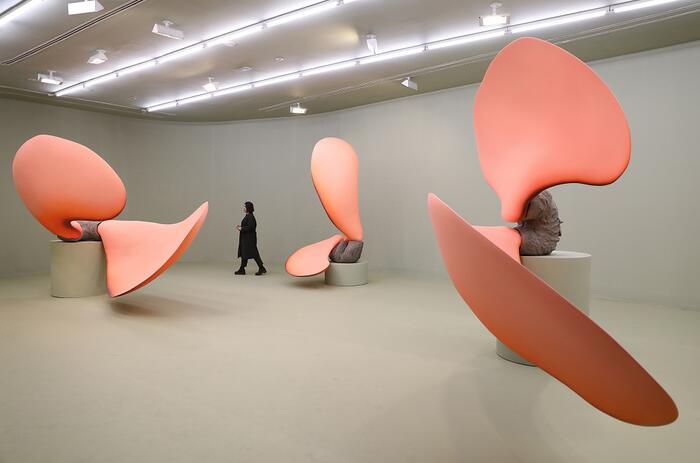
The exhibition Teresa Solar Abbourd. Pájaro sueño de máquina (Bird dream of machine) in CA2M Museum presents two large installations that condense the artist's research in recent years. It is curated by Tania Pardo and Claudia Segura Campins.
RESISTANCE AND EMPTINESS: TERESA SOLAR ABBOUD AT CA2M
The exhibition Teresa Solar Abbourd. Pájaro sueño de máquina (Bird dream of machine) in CA2M Museum presents two large installations that condense the artist's research in recent years. It is curated by Tania Pardo and Claudia Segura Campins.
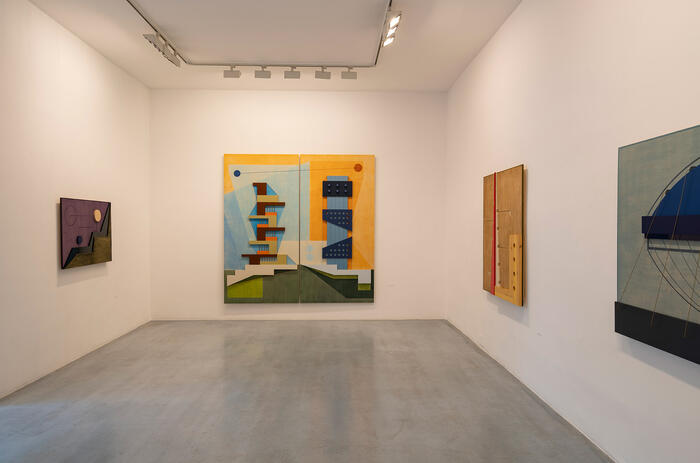
The Elba Benítez gallery presented Carlos Garaicoa's exhibition, entitled π=3,1416. The show is made up of a body of unpublished works born from the artist's desire to delve into the pictorial tradition of Latin American geometric abstraction, this time on wood.
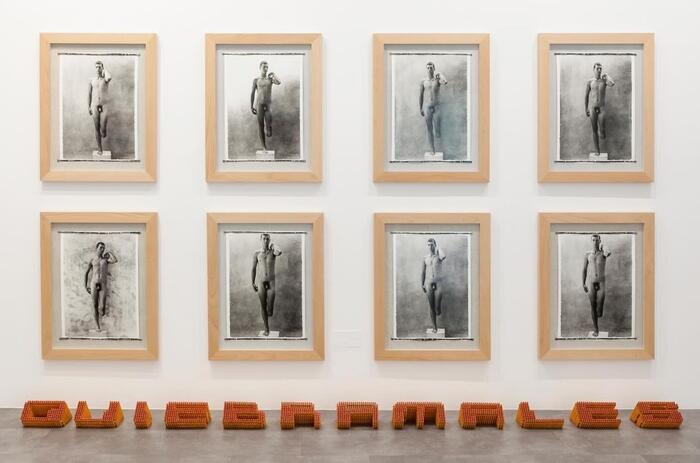
Quiebramales commemorates the twentieth anniversary of the conception of the David Quiebramales project. The exhibition at La Cometa gallery revisits the biopolitics that traverse the bodies affected by war, the structures that build (and destroy) a society, and education as a path to social justice.
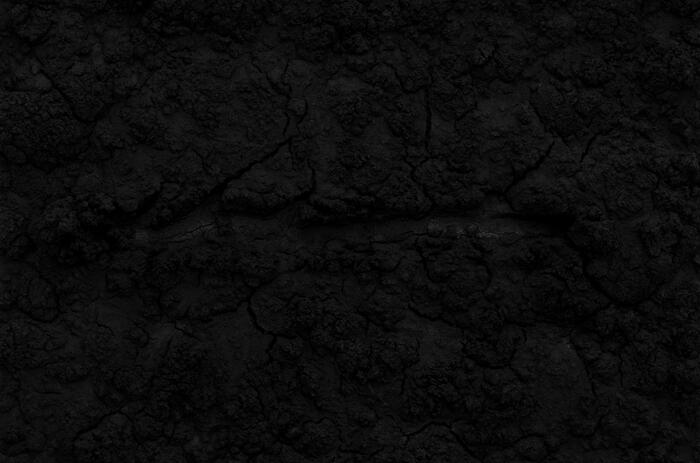
Bosco Sodi (Mexico, 1970) explores deeply in El día que nos volvimos a encontrar a universe quite distant from his recognizable large format and liveliness production to delve into the pleasures of the search for new material expressions and the abandonment of the chromatic in favour of texture, the depth of the absence of colour and concept.
BOSCO SODI AND THE VOLUME OF DARKNESS
Bosco Sodi (Mexico, 1970) explores deeply in El día que nos volvimos a encontrar a universe quite distant from his recognizable large format and liveliness production to delve into the pleasures of the search for new material expressions and the abandonment of the chromatic in favour of texture, the depth of the absence of colour and concept.
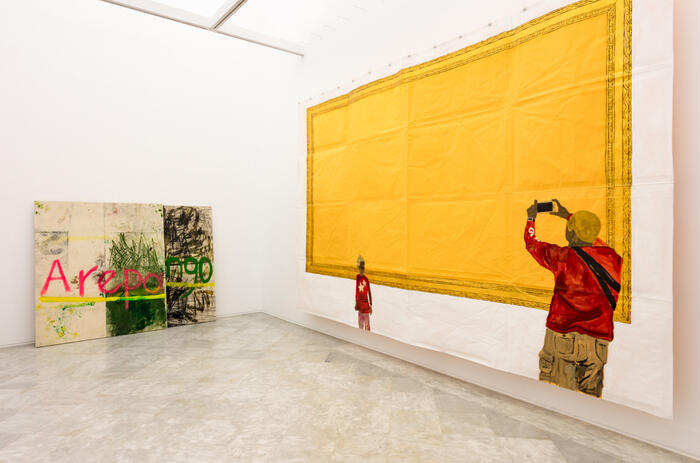
THE BALANCED REPRESENTATION OF LO LATINOAMERICANO IN THE JORGE M. PÉREZ COLLECTION
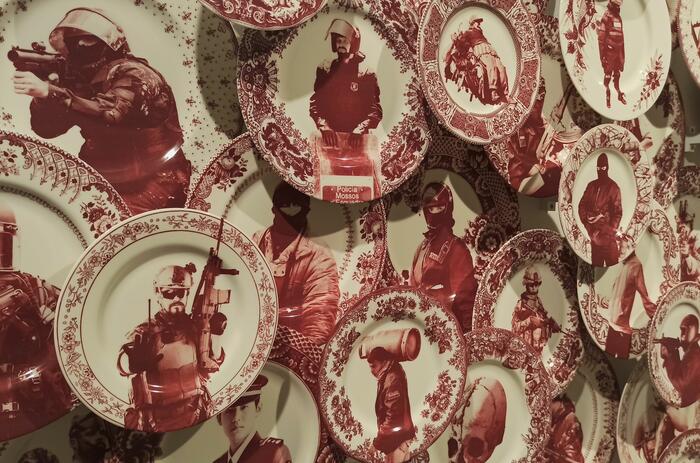
The Seville-based Fundación Valentín de Madariaga y Oya raises in its collective exhibition Herencia. Proyecto 360º the need to reconsider actions and return to the essential and almost primary link through the observation and analysis of our environment and its possibilities. The show gathers the work of fifteen international artists who become instrumental through their works for this purpose.
HERENCIA. PROYECTO 360º AND THE RECONSIDERATION OF OUR ACTIONS
The Seville-based Fundación Valentín de Madariaga y Oya raises in its collective exhibition Herencia. Proyecto 360º the need to reconsider actions and return to the essential and almost primary link through the observation and analysis of our environment and its possibilities. The show gathers the work of fifteen international artists who become instrumental through their works for this purpose.
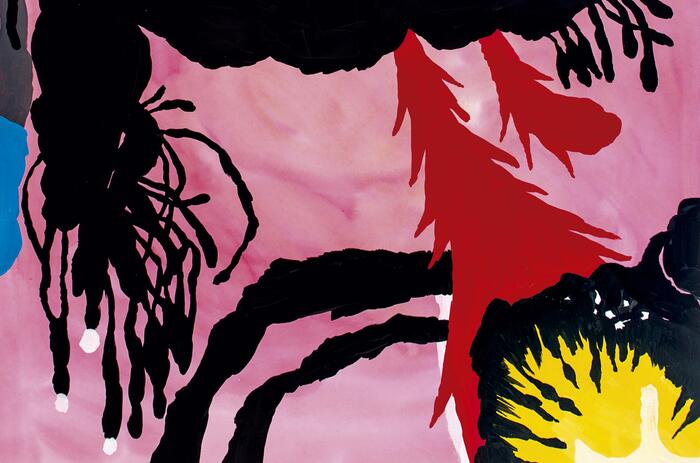
The Museo Extremeño e Iberoamericano de Arte Contemporáneo (MEIAC) in Badajoz is exhibiting, under the title Paisaje Transferido, a wide-ranging show by MartÍn Lopez Lam (Lima, Peru, 1981), one of the main exponents of graphic art in Spain, where he has been living for the last two decades.
MEIAC PRESENTS MARTÍN LÓPEZ LAM’S PAISAJE TRANSFERIDO
The Museo Extremeño e Iberoamericano de Arte Contemporáneo (MEIAC) in Badajoz is exhibiting, under the title Paisaje Transferido, a wide-ranging show by MartÍn Lopez Lam (Lima, Peru, 1981), one of the main exponents of graphic art in Spain, where he has been living for the last two decades.

Flavio Garciandía (Caibarién, Cuba, 1954) becomes the active and passive subject of his work in his first solo exhibition in Madrid.
FLAVIO GARCIANDÍA’S SELF-REVISIONISM
Flavio Garciandía (Caibarién, Cuba, 1954) becomes the active and passive subject of his work in his first solo exhibition in Madrid.

Casa de América inaugurated two exhibitions of Peruvian art: Memoria del Perú. Photographs 1890-1950, with works by various photographers that capture a significant period in the country's history, and Shipibo-Konibo. Portraits of my blood, with photographs by artist David Diaz on the life of the Shipibo-Konibo.
TWO EXHIBITIONS OF PERUVIAN PHOTOGRAPHY AT CASA DE AMERICA
Casa de América inaugurated two exhibitions of Peruvian art: Memoria del Perú. Photographs 1890-1950, with works by various photographers that capture a significant period in the country's history, and Shipibo-Konibo. Portraits of my blood, with photographs by artist David Diaz on the life of the Shipibo-Konibo.

The geometry in Jorge Cabieses' (Lima, Peru, 1971) usual outline is broken with the action of the spontaneity of the curved and almost organic stroke in his second solo exhibition in the Spanish capital. The Lima-born artist thus proposes, in a certain way, a dialogue between the artificial of the synthetic and the atavistic through the incorporation of those more spontaneous brushstrokes over the usual framework of rectitude that the artist usually presents.
CABIESES’ INTERCEPTED IMAGE
The geometry in Jorge Cabieses' (Lima, Peru, 1971) usual outline is broken with the action of the spontaneity of the curved and almost organic stroke in his second solo exhibition in the Spanish capital. The Lima-born artist thus proposes, in a certain way, a dialogue between the artificial of the synthetic and the atavistic through the incorporation of those more spontaneous brushstrokes over the usual framework of rectitude that the artist usually presents.

Two decades after Miguel Ángel Rojas (1946, Bogotá, Colombia) conceptualized in his project David Quiebramales his denunciation of violence and the use of education as the most efficient vehicle towards a catharsis for those who suffer it, the Madrid headquarters of La Cometa revisits his most emblematic work and reinterprets it as the framework for a kind of thematic retrospective. This commemoration of that first David Quiebramales reinforces a view that is still difficult to overcome and that, even today, serves to trace those harmful social dynamics that are created between society and war, the institutional and the political systems.
TOWARDS MIGUEL ÁNGEL ROJAS' QUIEBRAMALES
Two decades after Miguel Ángel Rojas (1946, Bogotá, Colombia) conceptualized in his project David Quiebramales his denunciation of violence and the use of education as the most efficient vehicle towards a catharsis for those who suffer it, the Madrid headquarters of La Cometa revisits his most emblematic work and reinterprets it as the framework for a kind of thematic retrospective. This commemoration of that first David Quiebramales reinforces a view that is still difficult to overcome and that, even today, serves to trace those harmful social dynamics that are created between society and war, the institutional and the political systems.

The exhibition Teresa Solar Abbourd. Pájaro sueño de máquina (Bird dream of machine) in CA2M Museum presents two large installations that condense the artist's research in recent years. It is curated by Tania Pardo and Claudia Segura Campins.
RESISTANCE AND EMPTINESS: TERESA SOLAR ABBOUD AT CA2M
The exhibition Teresa Solar Abbourd. Pájaro sueño de máquina (Bird dream of machine) in CA2M Museum presents two large installations that condense the artist's research in recent years. It is curated by Tania Pardo and Claudia Segura Campins.

The Elba Benítez gallery presented Carlos Garaicoa's exhibition, entitled π=3,1416. The show is made up of a body of unpublished works born from the artist's desire to delve into the pictorial tradition of Latin American geometric abstraction, this time on wood.

Quiebramales commemorates the twentieth anniversary of the conception of the David Quiebramales project. The exhibition at La Cometa gallery revisits the biopolitics that traverse the bodies affected by war, the structures that build (and destroy) a society, and education as a path to social justice.

Bosco Sodi (Mexico, 1970) explores deeply in El día que nos volvimos a encontrar a universe quite distant from his recognizable large format and liveliness production to delve into the pleasures of the search for new material expressions and the abandonment of the chromatic in favour of texture, the depth of the absence of colour and concept.
BOSCO SODI AND THE VOLUME OF DARKNESS
Bosco Sodi (Mexico, 1970) explores deeply in El día que nos volvimos a encontrar a universe quite distant from his recognizable large format and liveliness production to delve into the pleasures of the search for new material expressions and the abandonment of the chromatic in favour of texture, the depth of the absence of colour and concept.

THE BALANCED REPRESENTATION OF LO LATINOAMERICANO IN THE JORGE M. PÉREZ COLLECTION

The Seville-based Fundación Valentín de Madariaga y Oya raises in its collective exhibition Herencia. Proyecto 360º the need to reconsider actions and return to the essential and almost primary link through the observation and analysis of our environment and its possibilities. The show gathers the work of fifteen international artists who become instrumental through their works for this purpose.
HERENCIA. PROYECTO 360º AND THE RECONSIDERATION OF OUR ACTIONS
The Seville-based Fundación Valentín de Madariaga y Oya raises in its collective exhibition Herencia. Proyecto 360º the need to reconsider actions and return to the essential and almost primary link through the observation and analysis of our environment and its possibilities. The show gathers the work of fifteen international artists who become instrumental through their works for this purpose.

The Museo Extremeño e Iberoamericano de Arte Contemporáneo (MEIAC) in Badajoz is exhibiting, under the title Paisaje Transferido, a wide-ranging show by MartÍn Lopez Lam (Lima, Peru, 1981), one of the main exponents of graphic art in Spain, where he has been living for the last two decades.
MEIAC PRESENTS MARTÍN LÓPEZ LAM’S PAISAJE TRANSFERIDO
The Museo Extremeño e Iberoamericano de Arte Contemporáneo (MEIAC) in Badajoz is exhibiting, under the title Paisaje Transferido, a wide-ranging show by MartÍn Lopez Lam (Lima, Peru, 1981), one of the main exponents of graphic art in Spain, where he has been living for the last two decades.

Flavio Garciandía (Caibarién, Cuba, 1954) becomes the active and passive subject of his work in his first solo exhibition in Madrid.
FLAVIO GARCIANDÍA’S SELF-REVISIONISM
Flavio Garciandía (Caibarién, Cuba, 1954) becomes the active and passive subject of his work in his first solo exhibition in Madrid.

Casa de América inaugurated two exhibitions of Peruvian art: Memoria del Perú. Photographs 1890-1950, with works by various photographers that capture a significant period in the country's history, and Shipibo-Konibo. Portraits of my blood, with photographs by artist David Diaz on the life of the Shipibo-Konibo.
TWO EXHIBITIONS OF PERUVIAN PHOTOGRAPHY AT CASA DE AMERICA
Casa de América inaugurated two exhibitions of Peruvian art: Memoria del Perú. Photographs 1890-1950, with works by various photographers that capture a significant period in the country's history, and Shipibo-Konibo. Portraits of my blood, with photographs by artist David Diaz on the life of the Shipibo-Konibo.

The geometry in Jorge Cabieses' (Lima, Peru, 1971) usual outline is broken with the action of the spontaneity of the curved and almost organic stroke in his second solo exhibition in the Spanish capital. The Lima-born artist thus proposes, in a certain way, a dialogue between the artificial of the synthetic and the atavistic through the incorporation of those more spontaneous brushstrokes over the usual framework of rectitude that the artist usually presents.
CABIESES’ INTERCEPTED IMAGE
The geometry in Jorge Cabieses' (Lima, Peru, 1971) usual outline is broken with the action of the spontaneity of the curved and almost organic stroke in his second solo exhibition in the Spanish capital. The Lima-born artist thus proposes, in a certain way, a dialogue between the artificial of the synthetic and the atavistic through the incorporation of those more spontaneous brushstrokes over the usual framework of rectitude that the artist usually presents.

Two decades after Miguel Ángel Rojas (1946, Bogotá, Colombia) conceptualized in his project David Quiebramales his denunciation of violence and the use of education as the most efficient vehicle towards a catharsis for those who suffer it, the Madrid headquarters of La Cometa revisits his most emblematic work and reinterprets it as the framework for a kind of thematic retrospective. This commemoration of that first David Quiebramales reinforces a view that is still difficult to overcome and that, even today, serves to trace those harmful social dynamics that are created between society and war, the institutional and the political systems.
TOWARDS MIGUEL ÁNGEL ROJAS' QUIEBRAMALES
Two decades after Miguel Ángel Rojas (1946, Bogotá, Colombia) conceptualized in his project David Quiebramales his denunciation of violence and the use of education as the most efficient vehicle towards a catharsis for those who suffer it, the Madrid headquarters of La Cometa revisits his most emblematic work and reinterprets it as the framework for a kind of thematic retrospective. This commemoration of that first David Quiebramales reinforces a view that is still difficult to overcome and that, even today, serves to trace those harmful social dynamics that are created between society and war, the institutional and the political systems.

The exhibition Teresa Solar Abbourd. Pájaro sueño de máquina (Bird dream of machine) in CA2M Museum presents two large installations that condense the artist's research in recent years. It is curated by Tania Pardo and Claudia Segura Campins.
RESISTANCE AND EMPTINESS: TERESA SOLAR ABBOUD AT CA2M
The exhibition Teresa Solar Abbourd. Pájaro sueño de máquina (Bird dream of machine) in CA2M Museum presents two large installations that condense the artist's research in recent years. It is curated by Tania Pardo and Claudia Segura Campins.

The Elba Benítez gallery presented Carlos Garaicoa's exhibition, entitled π=3,1416. The show is made up of a body of unpublished works born from the artist's desire to delve into the pictorial tradition of Latin American geometric abstraction, this time on wood.

Quiebramales commemorates the twentieth anniversary of the conception of the David Quiebramales project. The exhibition at La Cometa gallery revisits the biopolitics that traverse the bodies affected by war, the structures that build (and destroy) a society, and education as a path to social justice.

Bosco Sodi (Mexico, 1970) explores deeply in El día que nos volvimos a encontrar a universe quite distant from his recognizable large format and liveliness production to delve into the pleasures of the search for new material expressions and the abandonment of the chromatic in favour of texture, the depth of the absence of colour and concept.
BOSCO SODI AND THE VOLUME OF DARKNESS
Bosco Sodi (Mexico, 1970) explores deeply in El día que nos volvimos a encontrar a universe quite distant from his recognizable large format and liveliness production to delve into the pleasures of the search for new material expressions and the abandonment of the chromatic in favour of texture, the depth of the absence of colour and concept.

THE BALANCED REPRESENTATION OF LO LATINOAMERICANO IN THE JORGE M. PÉREZ COLLECTION

The Seville-based Fundación Valentín de Madariaga y Oya raises in its collective exhibition Herencia. Proyecto 360º the need to reconsider actions and return to the essential and almost primary link through the observation and analysis of our environment and its possibilities. The show gathers the work of fifteen international artists who become instrumental through their works for this purpose.
HERENCIA. PROYECTO 360º AND THE RECONSIDERATION OF OUR ACTIONS
The Seville-based Fundación Valentín de Madariaga y Oya raises in its collective exhibition Herencia. Proyecto 360º the need to reconsider actions and return to the essential and almost primary link through the observation and analysis of our environment and its possibilities. The show gathers the work of fifteen international artists who become instrumental through their works for this purpose.

The Museo Extremeño e Iberoamericano de Arte Contemporáneo (MEIAC) in Badajoz is exhibiting, under the title Paisaje Transferido, a wide-ranging show by MartÍn Lopez Lam (Lima, Peru, 1981), one of the main exponents of graphic art in Spain, where he has been living for the last two decades.
MEIAC PRESENTS MARTÍN LÓPEZ LAM’S PAISAJE TRANSFERIDO
The Museo Extremeño e Iberoamericano de Arte Contemporáneo (MEIAC) in Badajoz is exhibiting, under the title Paisaje Transferido, a wide-ranging show by MartÍn Lopez Lam (Lima, Peru, 1981), one of the main exponents of graphic art in Spain, where he has been living for the last two decades.

Flavio Garciandía (Caibarién, Cuba, 1954) becomes the active and passive subject of his work in his first solo exhibition in Madrid.
FLAVIO GARCIANDÍA’S SELF-REVISIONISM
Flavio Garciandía (Caibarién, Cuba, 1954) becomes the active and passive subject of his work in his first solo exhibition in Madrid.

Casa de América inaugurated two exhibitions of Peruvian art: Memoria del Perú. Photographs 1890-1950, with works by various photographers that capture a significant period in the country's history, and Shipibo-Konibo. Portraits of my blood, with photographs by artist David Diaz on the life of the Shipibo-Konibo.
TWO EXHIBITIONS OF PERUVIAN PHOTOGRAPHY AT CASA DE AMERICA
Casa de América inaugurated two exhibitions of Peruvian art: Memoria del Perú. Photographs 1890-1950, with works by various photographers that capture a significant period in the country's history, and Shipibo-Konibo. Portraits of my blood, with photographs by artist David Diaz on the life of the Shipibo-Konibo.

The geometry in Jorge Cabieses' (Lima, Peru, 1971) usual outline is broken with the action of the spontaneity of the curved and almost organic stroke in his second solo exhibition in the Spanish capital. The Lima-born artist thus proposes, in a certain way, a dialogue between the artificial of the synthetic and the atavistic through the incorporation of those more spontaneous brushstrokes over the usual framework of rectitude that the artist usually presents.
CABIESES’ INTERCEPTED IMAGE
The geometry in Jorge Cabieses' (Lima, Peru, 1971) usual outline is broken with the action of the spontaneity of the curved and almost organic stroke in his second solo exhibition in the Spanish capital. The Lima-born artist thus proposes, in a certain way, a dialogue between the artificial of the synthetic and the atavistic through the incorporation of those more spontaneous brushstrokes over the usual framework of rectitude that the artist usually presents.

Two decades after Miguel Ángel Rojas (1946, Bogotá, Colombia) conceptualized in his project David Quiebramales his denunciation of violence and the use of education as the most efficient vehicle towards a catharsis for those who suffer it, the Madrid headquarters of La Cometa revisits his most emblematic work and reinterprets it as the framework for a kind of thematic retrospective. This commemoration of that first David Quiebramales reinforces a view that is still difficult to overcome and that, even today, serves to trace those harmful social dynamics that are created between society and war, the institutional and the political systems.
TOWARDS MIGUEL ÁNGEL ROJAS' QUIEBRAMALES
Two decades after Miguel Ángel Rojas (1946, Bogotá, Colombia) conceptualized in his project David Quiebramales his denunciation of violence and the use of education as the most efficient vehicle towards a catharsis for those who suffer it, the Madrid headquarters of La Cometa revisits his most emblematic work and reinterprets it as the framework for a kind of thematic retrospective. This commemoration of that first David Quiebramales reinforces a view that is still difficult to overcome and that, even today, serves to trace those harmful social dynamics that are created between society and war, the institutional and the political systems.

The exhibition Teresa Solar Abbourd. Pájaro sueño de máquina (Bird dream of machine) in CA2M Museum presents two large installations that condense the artist's research in recent years. It is curated by Tania Pardo and Claudia Segura Campins.
RESISTANCE AND EMPTINESS: TERESA SOLAR ABBOUD AT CA2M
The exhibition Teresa Solar Abbourd. Pájaro sueño de máquina (Bird dream of machine) in CA2M Museum presents two large installations that condense the artist's research in recent years. It is curated by Tania Pardo and Claudia Segura Campins.

The Elba Benítez gallery presented Carlos Garaicoa's exhibition, entitled π=3,1416. The show is made up of a body of unpublished works born from the artist's desire to delve into the pictorial tradition of Latin American geometric abstraction, this time on wood.

Quiebramales commemorates the twentieth anniversary of the conception of the David Quiebramales project. The exhibition at La Cometa gallery revisits the biopolitics that traverse the bodies affected by war, the structures that build (and destroy) a society, and education as a path to social justice.

Bosco Sodi (Mexico, 1970) explores deeply in El día que nos volvimos a encontrar a universe quite distant from his recognizable large format and liveliness production to delve into the pleasures of the search for new material expressions and the abandonment of the chromatic in favour of texture, the depth of the absence of colour and concept.
BOSCO SODI AND THE VOLUME OF DARKNESS
Bosco Sodi (Mexico, 1970) explores deeply in El día que nos volvimos a encontrar a universe quite distant from his recognizable large format and liveliness production to delve into the pleasures of the search for new material expressions and the abandonment of the chromatic in favour of texture, the depth of the absence of colour and concept.

THE BALANCED REPRESENTATION OF LO LATINOAMERICANO IN THE JORGE M. PÉREZ COLLECTION

The Seville-based Fundación Valentín de Madariaga y Oya raises in its collective exhibition Herencia. Proyecto 360º the need to reconsider actions and return to the essential and almost primary link through the observation and analysis of our environment and its possibilities. The show gathers the work of fifteen international artists who become instrumental through their works for this purpose.
HERENCIA. PROYECTO 360º AND THE RECONSIDERATION OF OUR ACTIONS
The Seville-based Fundación Valentín de Madariaga y Oya raises in its collective exhibition Herencia. Proyecto 360º the need to reconsider actions and return to the essential and almost primary link through the observation and analysis of our environment and its possibilities. The show gathers the work of fifteen international artists who become instrumental through their works for this purpose.

The Museo Extremeño e Iberoamericano de Arte Contemporáneo (MEIAC) in Badajoz is exhibiting, under the title Paisaje Transferido, a wide-ranging show by MartÍn Lopez Lam (Lima, Peru, 1981), one of the main exponents of graphic art in Spain, where he has been living for the last two decades.
MEIAC PRESENTS MARTÍN LÓPEZ LAM’S PAISAJE TRANSFERIDO
The Museo Extremeño e Iberoamericano de Arte Contemporáneo (MEIAC) in Badajoz is exhibiting, under the title Paisaje Transferido, a wide-ranging show by MartÍn Lopez Lam (Lima, Peru, 1981), one of the main exponents of graphic art in Spain, where he has been living for the last two decades.

Flavio Garciandía (Caibarién, Cuba, 1954) becomes the active and passive subject of his work in his first solo exhibition in Madrid.
FLAVIO GARCIANDÍA’S SELF-REVISIONISM
Flavio Garciandía (Caibarién, Cuba, 1954) becomes the active and passive subject of his work in his first solo exhibition in Madrid.

Casa de América inaugurated two exhibitions of Peruvian art: Memoria del Perú. Photographs 1890-1950, with works by various photographers that capture a significant period in the country's history, and Shipibo-Konibo. Portraits of my blood, with photographs by artist David Diaz on the life of the Shipibo-Konibo.
TWO EXHIBITIONS OF PERUVIAN PHOTOGRAPHY AT CASA DE AMERICA
Casa de América inaugurated two exhibitions of Peruvian art: Memoria del Perú. Photographs 1890-1950, with works by various photographers that capture a significant period in the country's history, and Shipibo-Konibo. Portraits of my blood, with photographs by artist David Diaz on the life of the Shipibo-Konibo.

The geometry in Jorge Cabieses' (Lima, Peru, 1971) usual outline is broken with the action of the spontaneity of the curved and almost organic stroke in his second solo exhibition in the Spanish capital. The Lima-born artist thus proposes, in a certain way, a dialogue between the artificial of the synthetic and the atavistic through the incorporation of those more spontaneous brushstrokes over the usual framework of rectitude that the artist usually presents.
CABIESES’ INTERCEPTED IMAGE
The geometry in Jorge Cabieses' (Lima, Peru, 1971) usual outline is broken with the action of the spontaneity of the curved and almost organic stroke in his second solo exhibition in the Spanish capital. The Lima-born artist thus proposes, in a certain way, a dialogue between the artificial of the synthetic and the atavistic through the incorporation of those more spontaneous brushstrokes over the usual framework of rectitude that the artist usually presents.

Two decades after Miguel Ángel Rojas (1946, Bogotá, Colombia) conceptualized in his project David Quiebramales his denunciation of violence and the use of education as the most efficient vehicle towards a catharsis for those who suffer it, the Madrid headquarters of La Cometa revisits his most emblematic work and reinterprets it as the framework for a kind of thematic retrospective. This commemoration of that first David Quiebramales reinforces a view that is still difficult to overcome and that, even today, serves to trace those harmful social dynamics that are created between society and war, the institutional and the political systems.
TOWARDS MIGUEL ÁNGEL ROJAS' QUIEBRAMALES
Two decades after Miguel Ángel Rojas (1946, Bogotá, Colombia) conceptualized in his project David Quiebramales his denunciation of violence and the use of education as the most efficient vehicle towards a catharsis for those who suffer it, the Madrid headquarters of La Cometa revisits his most emblematic work and reinterprets it as the framework for a kind of thematic retrospective. This commemoration of that first David Quiebramales reinforces a view that is still difficult to overcome and that, even today, serves to trace those harmful social dynamics that are created between society and war, the institutional and the political systems.

The exhibition Teresa Solar Abbourd. Pájaro sueño de máquina (Bird dream of machine) in CA2M Museum presents two large installations that condense the artist's research in recent years. It is curated by Tania Pardo and Claudia Segura Campins.
RESISTANCE AND EMPTINESS: TERESA SOLAR ABBOUD AT CA2M
The exhibition Teresa Solar Abbourd. Pájaro sueño de máquina (Bird dream of machine) in CA2M Museum presents two large installations that condense the artist's research in recent years. It is curated by Tania Pardo and Claudia Segura Campins.

The Elba Benítez gallery presented Carlos Garaicoa's exhibition, entitled π=3,1416. The show is made up of a body of unpublished works born from the artist's desire to delve into the pictorial tradition of Latin American geometric abstraction, this time on wood.

Quiebramales commemorates the twentieth anniversary of the conception of the David Quiebramales project. The exhibition at La Cometa gallery revisits the biopolitics that traverse the bodies affected by war, the structures that build (and destroy) a society, and education as a path to social justice.

Bosco Sodi (Mexico, 1970) explores deeply in El día que nos volvimos a encontrar a universe quite distant from his recognizable large format and liveliness production to delve into the pleasures of the search for new material expressions and the abandonment of the chromatic in favour of texture, the depth of the absence of colour and concept.
BOSCO SODI AND THE VOLUME OF DARKNESS
Bosco Sodi (Mexico, 1970) explores deeply in El día que nos volvimos a encontrar a universe quite distant from his recognizable large format and liveliness production to delve into the pleasures of the search for new material expressions and the abandonment of the chromatic in favour of texture, the depth of the absence of colour and concept.

THE BALANCED REPRESENTATION OF LO LATINOAMERICANO IN THE JORGE M. PÉREZ COLLECTION

The Seville-based Fundación Valentín de Madariaga y Oya raises in its collective exhibition Herencia. Proyecto 360º the need to reconsider actions and return to the essential and almost primary link through the observation and analysis of our environment and its possibilities. The show gathers the work of fifteen international artists who become instrumental through their works for this purpose.
HERENCIA. PROYECTO 360º AND THE RECONSIDERATION OF OUR ACTIONS
The Seville-based Fundación Valentín de Madariaga y Oya raises in its collective exhibition Herencia. Proyecto 360º the need to reconsider actions and return to the essential and almost primary link through the observation and analysis of our environment and its possibilities. The show gathers the work of fifteen international artists who become instrumental through their works for this purpose.

The Museo Extremeño e Iberoamericano de Arte Contemporáneo (MEIAC) in Badajoz is exhibiting, under the title Paisaje Transferido, a wide-ranging show by MartÍn Lopez Lam (Lima, Peru, 1981), one of the main exponents of graphic art in Spain, where he has been living for the last two decades.
MEIAC PRESENTS MARTÍN LÓPEZ LAM’S PAISAJE TRANSFERIDO
The Museo Extremeño e Iberoamericano de Arte Contemporáneo (MEIAC) in Badajoz is exhibiting, under the title Paisaje Transferido, a wide-ranging show by MartÍn Lopez Lam (Lima, Peru, 1981), one of the main exponents of graphic art in Spain, where he has been living for the last two decades.

